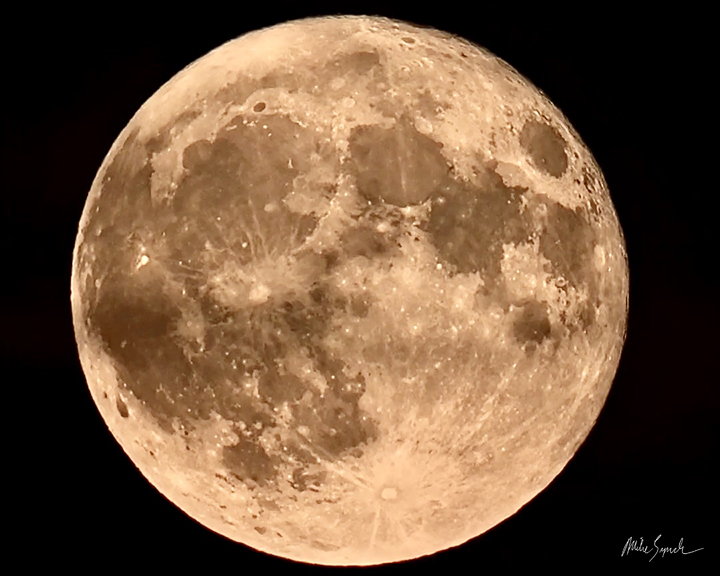
Skywatch: Harvest moon shining bright with a power failure
“Shine on Harvest Moon,” a song well over a century old, will undoubtedly be playing in my head this week. OK, I’m showing my age! You may not have heard of this tune if you’re under 50. Google it or check it out on YouTube. I’m not afraid to say it’s one of my favorite lunar tunes.
We officially have a full harvest moon this Wednesday night that will linger in the sky through next weekend and beyond. Some consider it a “supermoon” since the full moon is a little closer to Earth on average. Honestly, though, it won’t really look all that different from any other full moon. It’ll be a little larger and brighter than average, but calling it super is a bit much in my book. Like many things, it’s hyped.
What is truly unusual about the full moon Wednesday night is that the extreme upper edge of the moon’s disk will have a very slight blackout from 9:12 to 10:15 p.m., with the maximum darkening around 9:44 p.m. What’s going on is a very minor partial lunar eclipse. The moon, in its 27.3-day orbit around the Earth, is grazing the outer edge of its darker umbra shadow.
It’s called the harvest moon because it’s the closest full moon to the autumnal equinox date, or the first day of fall, which is coming next Sunday, Sept. 22. Astronomically, the harvest moon is special because of the unique celestial mechanics this time of year. Because of its orbit around the Earth, the moon constantly migrates eastward among the stars. That causes it to rise about 30 to 60 minutes later from night to night. Around the autumnal equinox date, though, the moon rises only 20 minutes later each night. The exact details of why this happens are a bit hairy to go into now, but it has to do with our Earth’s axis being tilted to its orbit around the sun. It also has to do with the angle of the ecliptic, the sun and moon’s path among the stars, and the celestial equator, a projection in the sky of the Earth’s equator. This time of year, the full moon is at the intersection of the ecliptic and celestial equator, and because of that, the full moon’s path among the stars is nearly parallel to the horizon. Confused? I told you the details were hairy.
It’s called the harvest moon because it historically helped farmers get their crops in this time of year. In the days before lights on tractors, farmers used every speck of daylight they could to bring in the crops, and when they got the full moon, they also used its dim light and pulled “all-nighters.” The beauty of the harvest moon for them was since it rose less than a half hour later each evening, there wasn’t much of a gap between sunlit days and moonlit nights, at least for a few days after the official date of the full moon.
The harvest moon is often depicted as a giant bright orange orb, but any full moon always looks much bigger and more colorful when rising or setting than overhead. The moon sports that orange-red color when it rises or sets because when it’s close to the horizon, we see it through the thicker and dustier layers of Earth’s atmosphere. That scatters away all but the reddish components of the moon’s white light. When the moon is higher, and we don’t see the moon through as much of our atmosphere, the scattering effect disappears.
As far as full moons looking much larger when they rise or set, that’s simply an optical illusion. Prove that to yourself by holding a nickel out at arm’s length to the moon when it’s barely above the horizon rising and again at its highest point around midnight, and you’ll see that your nickel will cover the same amount of the moon.
For amateur astronomers and stargazers like myself, serious stargazing is shut down during a full moon. There’s just too much light in the sky. It’s a really good thing that we have the moon up there in the heavens because it provides a wonderful stabilizing effect on the Earth. It keeps our Earth’s axis from wobbling too much. Without the moon’s gravitational tug, it’s thought that the gravitational force of Jupiter, as well as other planets, would cause the Earth’s axis to wobble chaotically and quickly, causing Earth’s seasons and our climate to be thrown way out of whack. Maybe without the moon, we wouldn’t be here. As you gaze lovingly on the harvest moon, think of that and say thanks to the moon, but don’t let anybody hear you. You don’t want to be called a lunatic.
Mike Lynch is an amateur astronomer and retired broadcast meteorologist for WCCO Radio in Minneapolis/St. Paul. He is the author of “Stars: a Month by Month Tour of the Constellations,” published by Adventure Publications and available at bookstores and adventurepublications.net. Mike is available for private star parties. You can contact him at mikewlynch@comcast.net.
Starwatch programs
Wednesday, Sept. 18, 8-10 p.m., Loring Park in Minneapolis. For more information, call 612-230-6400 or or visit www.minneapolisparks.org/parks-destinations/parks-lakes/loring_park/
Thursday, Sept. 19, 7:30-9:30 p.m., Shakopee, Shakopee Community Education. For more information and reservations and location, call Shakopee Community Education at 952-496-5029 or visit www.shakopee.k12.mn.us/domain/67
Friday, Sept. 20, 7:30-9:30 p.m. through the City of Ramsey. For more information, location and reservations call 763-443-9883 or visit www.ci.ramsey.mn.us/269/Parks-and-Recreation
Saturday, Sept. 21, 7:30-9:30 p.m., North Oaks at Chippewa Middle School. For more information and reservations call 651-621-0020 or visit www.moundsviewschools.org/communityeducation

